#from incarcerated to incorporated
Text
youtube
Cooking hot chicken burritos, nuggets and fried chicken in prison| From Incarcerated to Incorporated
Unleash your culinary passion and embark on a transformative journey from “Incarcerated to Incorporated” with our groundbreaking program, where inmates learn to cook hot chicken burritos, nuggets, and fried chicken in prison. Through hands-on training and mentorship, participants gain valuable culinary skills and business knowledge, empowering them to redefine their future beyond incarceration. The keyword highlight, “cooking hot chicken burritos, nuggets, and fried chicken in prison,” showcases the program’s dedication to providing inmates with meaningful opportunities, breaking barriers, and paving the way for a successful transition to entrepreneurship. Join us in rewriting the narrative and unlocking a world of possibilities through the art of cooking.
#prison cooking#chicken nuggets#fried chicken#from incarcerated to incorporated#hot chicken#burritos#prison videos#unique recipes#culinary journey#behind bars#inmate cuisine#flavorful dishes#unconventional cooking#inspiring transformation#delicious prison food#from prison to entrepreneurship#Youtube
0 notes
Text
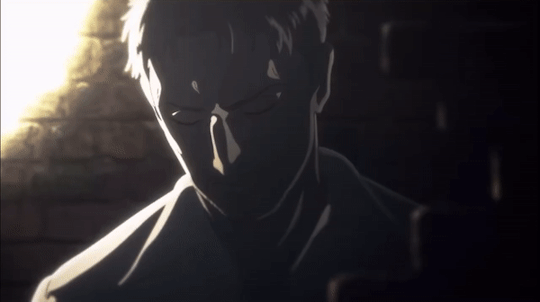
I can’t believe it’s the last day of our event (!!!), but let me remind you that submissions are welcome till the 4th of February. Please, please make sure to meet the deadline.
Today I’m offering you some headcanons regarding the Titan Shifters’ biology and a concept for a fic I definitely want to write in the future.
ReiJeanWeek 2024, day 5, prompt: Titan Biology
warnings: filth, pure filth, NSFW.
Again, if you read my fics you know well how much I love abusing the Shifters’ regenerative powers. Reiner is the main object of my experiments, and this post is of course going to focus on him (and on the consequences for Jean). You know already that my Reiner can channel his Titan powers when in human form, hardening certain body parts during sex, regenerating so that he can keep going at it for hours (remember his steaming dick? That was fun), increasing his own stamina on demand etc. He’s always running hot, his eyes are shining just like the Armor’s when he’s horny, and he loves to bite… like a proper Titan. Lately I’ve been also leaning into the idea of Reiner being able to regenerate thanks to sex. While Jean is getting understandably tired during the act, Reiner is becoming more and more energized. But let’s take this concept even a little further…
Titan biology 101:
1) Sex speeds up Shifters’ regeneration process or even triggers it if a Shifter is in a really bad shape. Even a blow job will suffice.
2) Titan Shifters have special… properties and subconsciously imprint on their partners. If their partner gets pregnant, the child will be a perfect Shifter candidate/match for their father’s Titan (if the situation is reversed and a Shifter gets pregnant, it works the same). It’s not like a Shifter can just pass on their Titan abilities to an embryo, but they leave something behind in their partner’s body.
3) Building on point 2, that something they leave behind gets incorporated into their partner’s body if they are also an Eldian — just like mindless Titans want to devour a Shifter when given a chance, their bodies have a similar subconscious need. So, their bodies devour whatever a Shifter gives them (fluids) and in a way, bond with them. It’s not like a full mating process, but it leaves both the Shifter and their partner more in tune with each other. They suddenly know each other’s feelings, they are more aware of each other and can read each other’s intentions better. It’s definitely weird in everyday life, but very useful on the battlefield.
Now that we've established the above, let’s move on to my WIP:
Eren and Zeke escape together during the Raid on Liberio, and Reiner is caught and brought to Paradis in their place. Disillusioned with himself, the Warriors’ mission and ready to die, he gives up completely and confesses to everything he’s done, including his involvement in Marco’s death. Jean reacts like he reacted in canon, beating the shit out of him. Without the buffer in the form of Gabi, Levi is the one who stops him from going too far. After a short, but very meaningful conversation with both Levi and Hange, Jean is ordered to go back to Trost – and stay away from Reiner who is now a valuable hostage.
Braun is kept away from civilization, deep in the forest, just where Zeke was supposed to be “incarcerated”. He becomes Hange’s lab rat and, not caring what becomes of him, he allows them to do whatever they want. Even though Hange is far from being cruel on purpose, Reiner constantly finds himself missing his limbs or otherwise incapacitated. When Hange is suddenly needed elsewhere, Levi orders Jean to keep an eye on Braun and Hange’s assistants. The captain is testing him, and Jean knows he needs to behave.
Reiner is of course terrified to see him again, but Jean informs him he no longer wants revenge. He can’t force himself to take pleasure in kicking Braun when he's already down. Especially since Reiner wanted to be punished and hurt. He wanted someone to kill him. To spite him, and to bring some relief to his own broken heart, Jean decides to help Reiner. To take care of him in a world where everyone wishes him ill.
Jean regularly berates the soldiers if they leave Reiner in a bad shape after the experiments. He knows what torture looks like. Reiner is there to help them propel their research, to atone for his sins. Not to become a toy a group of children wants to tear into pieces. Jean helps Reiner back to his tent every night, making sure he’s more or less in one piece. He honestly thought he would find taking care of Braun more difficult, more disgusting, but it’s not that bad. Maybe because Reiner keeps his fucking mouth shut most of the time.
Reiner is struggling with regeneration. It’s as if he was growing weaker with each passing day; it’s not only about growing his limbs back, but also about healing simple scraps and bruises. Jean begins to suspect it might be related to regular blood loss, but the experiments cannot be put on hold — at least until Hange comes back. Jean worries that Reiner will die before they learn anything useful. Or that Reiner will die, period. Jean tries to persuade the soldiers and Hange’s assistants to go easier on Braun which of course results in them speculating about the nature of their relationship.
And Jean knows he’s going too far, he knows he’s becoming way too concerned with Reiner’s well-being. At some point he even notices that Reiner… has an uncontrollable chub whenever Jean is manhandling him and helping him into his sleeping bag. He’s trying to ignore it for some time, both for his and Reiner’s sanity, but eventually he has to react. It happens on a day when Braun loses all of his limbs during an experiment again, and Jean is barely able to keep him from bleeding out. Once the situation is more or less under control, with Reiner in his sleeping bag, looking about to die with a boner, Jean simply goes: “When was the last time you jerked off?”. Now Braun really looks ready to die, and Jean almost threatens him with a handjob to get them out of that pathetic situation once and for all. Reiner reluctantly accepts, probably fearing for his dick’s safety.
So, Jean helps him. It’s very quick and extremely awkward — it doesn’t take more than a few confident strokes for Reiner to cum… And as soon as that happens, one of his arms grows back. It happens so fast, they’re both equally shocked. Previously it took Reiner a whole week to get a limb back, and now it happened in a blink of an eye. Jean decides to leave the rest of… the regeneration process to Reiner, and excuses himself from his tent. In the morning Braun has all limbs in place and looks embarrassed as hell because Jean knows exactly how he got them back. Honestly, it’s a little funny. Perfect blackmail material.
Things are good for some time after that. Reiner feels and looks better, there are no surprise erections — at least until the experiments go too far again, leaving him in pieces Jean has to pick up. When Jean is gently taking care of him later that day, they decide to… carry on with their own experiment.
The day they go all the way and fuck, the imprinting happens. It’s not something Reiner knows about, it’s definitely not something anyone warned the Warriors about, and the two of them only discover the truth when one night Jean goes into the forest to pee, walks with his face into a cobweb and loses his shit. Reiner senses it from the other side of the camp and almost shifts.
Hange: “It’s the best day ever.”
#ReiJeanWeek2024#reijean#reiner x jean#veecanons#jean kirstein#jean kirschtein#reiner braun#attack on titan#aot#snk#shingeki no kyojin
33 notes
·
View notes
Text
The California governor, Gavin Newsom, has announced a plan to transform the state’s oldest prison into a center for rehabilitation, education and training, modeled after Norwegian incarceration systems, which are much less restrictive than US facilities.
Newsom told the Los Angeles Times on Thursday that his goal was “ending San Quentin [prison] as we know it” and working to “completely reimagine what prison means”. San Quentin, located on a peninsula in the San Francisco Bay Area and established in 1852, houses nearly 4,000 people, including hundreds on its infamous death row, the largest in the US, which is on track to be dismantled.
The Democratic governor said that by 2025, he plans to transition the massive penitentiary into a final stop of incarceration before individuals are released, with a focus on job training for trades, including plumbers, electricians or truck drivers, the LA Times reported. His recently released budget proposal includes $20m to start the effort.
“The ‘California Model’ the governor is implementing at San Quentin will incorporate programs and best practices from countries like Norway, which has one of the lowest recidivism rates in the world – where approximately three in four formerly incarcerated people don’t return to a life of crime,” the governor’s office said in a statement on Thursday. The prison will be renamed the San Quentin Rehabilitation Center.

Pictured: Instructor Douglas Arnwine hands back papers with comments to his students at San Quentin state prison in April 2022.
The transformation Newsom has described would, at least for San Quentin, mark a fundamental shift from the extremely punitive American system. The US has the highest reported incarceration rate in the world...
Although California is considered a leader in criminal justice reform, the state’s prison system continues to be overcrowded, with thousands of elderly people languishing behind bars and Black residents disproportionately imprisoned for decades due to harsh sentencing laws adopted in the 1990s.
Scandinavian models of incarceration that have garnered increasing attention from some US lawmakers are less focused on punishment and are meant to give imprisoned people support and a sense of normal life behind bars so that they are prepared to reintegrate into society. That can mean access to personal computers, televisions and showers, consistent classes and programming, fresh food, more freedom of movement and stronger connections with the outside world.
“Do you want them coming back with humanity and some normalcy, or do you want them coming back more bitter and more beaten down?” Newsom told the LA Times.
An overhaul of San Quentin would be a huge undertaking, and there are significant unanswered questions about what the transition would mean for its current residents as well as the tens of thousands of others located across the California department of corrections and rehabilitation (CDCR). San Quentin has a long and recent history of scandals involving abuse, overcrowding, guard misconduct and medical neglect. It is also a prison that has significantly more programming than some of the remote and rural CDCR prisons, with a renowned podcast produced by incarcerated San Quentin journalists.
The governor’s office noted research showing that every $1 spent on rehabilitation saves more than $4 on costs of re-incarceration; that people who enroll in education programs behind bars are 43% less likely to return to prison; and that crime survivor groups say victims prefer sentences that include programming designed to prevent recidivism...
Assemblymember Mia Bonta noted that California spends $14.5bn on prisons each year – $106,000 a person – but traditionally puts only about 3.4% toward rehabilitation: “It’s time for a significant paradigm shift.”
One of the reporters in attendance was Steve Brooks, an incarcerated journalist and editor of the San Quentin News paper, who asked the governor how the Scandinavian model would be adopted in a prison where residents remain concerned about overcrowding and the living conditions. Brooks also said people were concerned that those convicted of violent offenses would be excluded from programs under a new system. Newsom responded, “I’m not looking to cherry pick certain offenses. I’m for people who are committed, not passively interested, in changing themselves.”
-via The Guardian, 3/17/23
#california#united states#us politics#prison#prison industrial complex#prison reform#incarceration#san quentin#scandinavian#gavin newsom#good news#hope
109 notes
·
View notes
Text
The taunting: Undertaker
and Prince Soma

Some thoughts about Chapter 24: The Butler, Onstage and the “Book of Circus’”second episode because I am revisiting the arc due to the recent chapters.
If one is still baffled as to why Ciel Phantomhive decided to take on Undertaker’s challenge, one has to read the manga, too, in order to see the reasons Ciel did it. The “it” being the “payment” he bestowed on the mortician in order to gain more knowledge on the missing children and their connection to the travelling circus troupe. It lead to so many different speculations as to what exactly Ciel had really done. (Anyway, I have one that I incorporated to my head canon written on my fan fiction/interpretation later.)
The scenes and the manga caps reveal the sinister side of the mortician however. They are screaming at me for recognition how cruel Undertaker has been for rubbing this fact on Ciel’s face.
“In the underworld, you see dead children every day after all… You’re wellllll aware of that, aren’t you, Earl?”
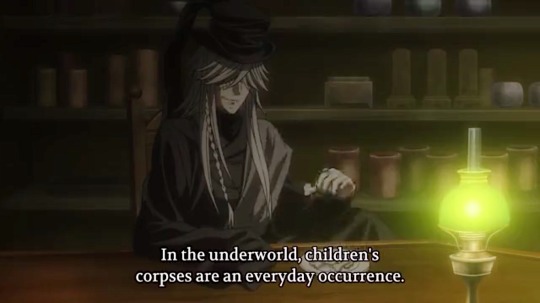
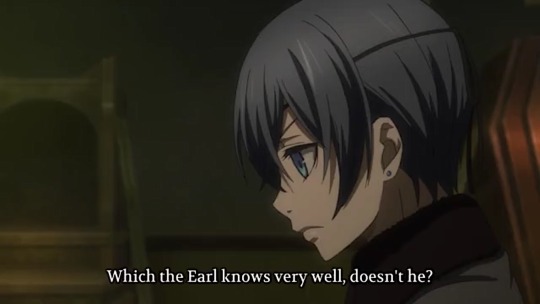
We know how uncomfortable he is when dealing with Undertaker due to his odd manners.
It was a reminder that Ciel knew by heart. Ciel should have taken it as a hint, a red flag if you would, concerning Undertaker’s chosen words that somehow the mortician knew something about his abduction/incarceration. That should have planted the seeds of doubt on him. But thinking that the mortician was somehow a confidante of his father’s, he took it in stride.
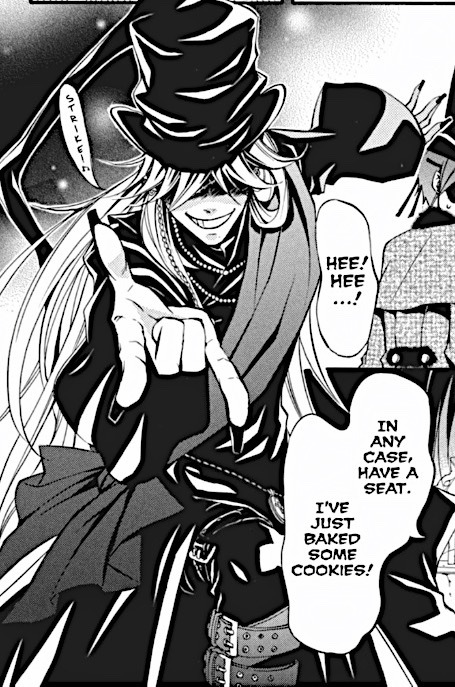

Now, why was Ciel so desperate to accomplish the task? Look no further to Chapter 23. Ciel appointed Prince Soma as the caretaker of his townhouse in London after a chaos ensued. It happened at the end of the Indian Butler arc. Agni, was ready to turn himself in, atone for the sins he committed, prepared to do the right thing. But drastic measures hindered him to do what he wanted. It was a mix of comedic gags and violent measures from S admonishing the Indian butler would not only endanger Ciel’s standing in the society, but would also cause desperation to his own master, Prince Soma, if he was really imprisoned. It was also in the same chapter where Abberline found out the deal between the Phantomhives and the English royalty.
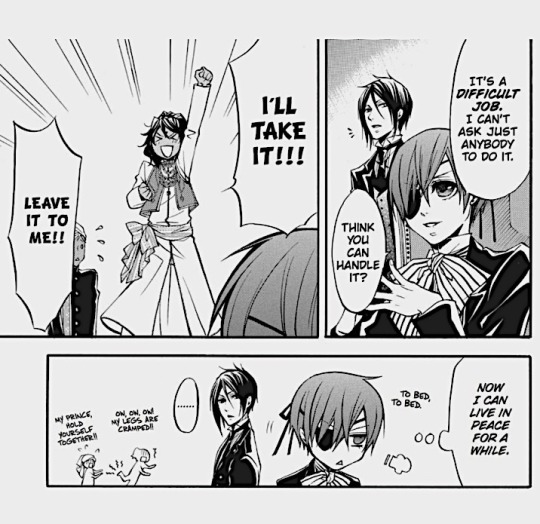
Ciel was impatient to return to the Manor. There was no good excuse to stay in London anymore when Prince Soma and Agni were staying there. He thought of the Indian prince’s petty insults of his height, his loneliness (no family members, no relatives and no friends to call), and his age. (Yes, Ciel had his aunt and cousins but he never bothered with them and the prince was not aware of it.) While Agni, who worshipped his master through and through, only looked on proudly at his ward thinking he was only giving advices as an older person imparting his knowledge to a much younger Ciel. Agni didn’t notice how uneasy this made the Earl. Agni is very much like a mother hen who spoils rotten their children, unaware of finding what is wrong.
There lies Ciel’s pride, who refuses to depend on any human being. He, who lost his family, must not rely on someone else’s assurance for support as they have their own personal aims. He was determined to do it on his own. That’s why it was understandable that the young aristocrat was eager to solve the missing children’s case in whatever form.
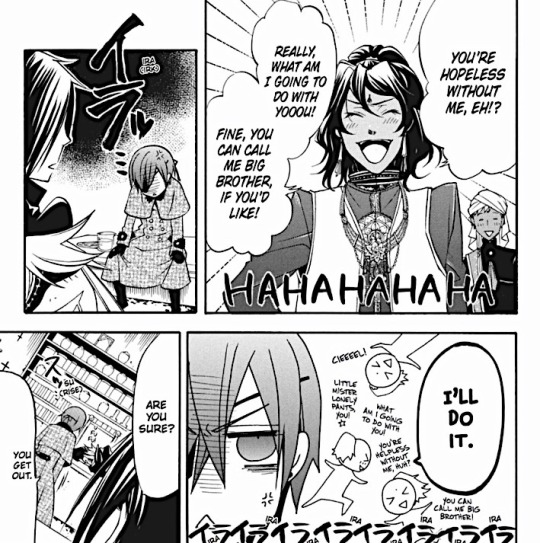
That, later, Undertaker also highlighted this dependence on his butler.
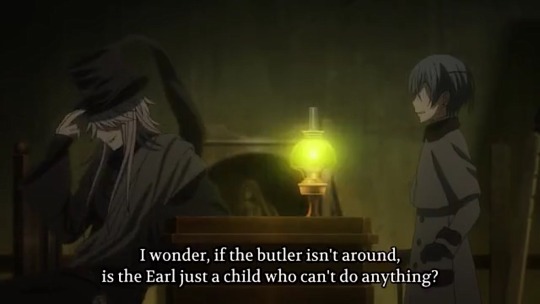
The anime version omitted these parts from the manga and left that tension courtesy of Undertaker alone.
This is the reason he decided on taking the challenge by himself. He had enough of the sarcastic remarks he received from the prince and the mortician. He wanted them to see him as a person, not a mere immature child, capable of making decisions and accomplishing tasks relegated to him by the Queen as her Watchdog. He wanted them to see him as their equal, despite his young age and diminutiveness, worthy of respect. Most of all, as an avid chess player, by not needing anyone he only regarded them as his pawns.
And boy, how wrong he was.
#kuroshitsuji#black butler#sebastian michaelis#ciel phantomhive#yana toboso#undertaker!#undertaker#prince soma#chapter 23#chapter 24#kuroshitsuji: book of circus#wall of t e x t#kuroshitsuji meta#kuroshitsuji analysis
133 notes
·
View notes
Note
WHERE DO DWAYNE MCDUFFIE'S VARIOUS WORKS LAND IN THIS HYPOTHETICAL TIMELINE
especially since in this timeline the Tommy Westphall Universe hypothesis was postulated by him
Got his start as an editor at DC in the 1980s, where his first major work was The Suicide Squad, a miniseries positing that supervillains are incarcerated rather than killed because society seeks to exploit their labor. As a freelancer, he'd do most of his noteworthy work for Marvel; he sought to improve the poor state of minority representation in comics at the time, and created many of Marvel's best-regarded black superheroes, like 3-D Man, Storm, Static, and the Punisher, all of whom would eventually be incorporated into the main Marvel universe.
Static, or Miles Morales, was especially popular, and got his own four-season show, Static Shock, which aired on Cartoon Network. This was the start of a long series of Cartoon Network writing and directing credits that Dwayne McDuffie received; he was a leading figure in multiple highly-regarded Spider-Man shows, they brought him on to run all three Inspector Gadget sequel series (interrupted only by his death), and he even had a presence in reboots of The Avengers and Crazy Train. He died suddenly in 2011, relatively early in what surely would have otherwise continued to be a productive and prolific career. He is still remembered very fondly today, and has inspired many memorials and tribute characters.
As for "Six Degrees of the Queen of the Asteroids", it was a blog post that McDuffie wrote in 2002 for defunct comics site Slush Factory. In response to questions about the continuity of his own comics, Static Shock, and Bruce Timm's AMU, McDuffie reflects on the attitude that working in comics has given him about canon, crossovers, and shared universes. As a reductio ad absurdum, he points out the extensive network of Easter eggs that Pixar likes to use to link their films together. (There were only four at the time, with Shark Tale still on the way.) He then goes into a series of strange rationalizations you would need to make to explain how they could all be set in the same universe, if you were applying the same attitude to them that many fans try to apply to superheroes. Unfortunately, the internet generally disregarded the context of McDuffie's argument, and accepted the ideas he had intended to be ridiculous at face value. The so-called "Pixar Theory" remains a frequent subject of braindead fan discussion to this day, with each new release from the studio prompting a new round of speculation as to how it could be shoehorned into a shared universe.
8 notes
·
View notes
Text
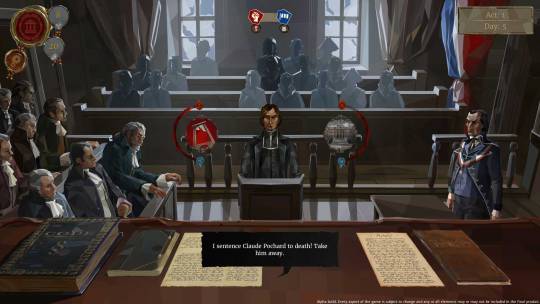


While many additional gameplay conceits are unveiled during play, the core focus of We. The Revolution places the player in the role of a judge hearing cases and doling out sentences based on the evidence and testimonies provided. While at first this gains increasing complexity through the inclusion of a great density of information scattered across various bodies of text, eventually the player has to incorporate their understanding of how the jury, and eventually, the larger populace, feels about the defendants in each instance, with the consequences for going against them too often leading to their own incarceration or death. This, over time, slowly changes the onus of the trials from exercises in finding the truth, to determining how to best walk the tightrope of following the law and following the crowd, with neither option being truly blameless.
19 notes
·
View notes
Text
youtube
0:10Social movements fight for it.
0:12Politicians promise it.
0:14Police say they enforce it.
0:16And judges and courts claim to embody it.
0:19Yet in an age of intense polarization,
0:22stark divisions have emerged
0:23over exactly what justice looks like
0:26and how to enact it.
0:28So what is justice after all?
0:30And what do anarchists have to say about it?
0:33Justice is a fundamental ethical,
0:35philosophical,
0:36and political concept
0:37that shapes our lives
0:38in countless ways every single day.
0:41The decisions we make are influenced
0:42by our own inner sense of right and wrong,
0:45society's expectations,
0:47and the implicit threat of punishment.
0:49Children navigate justice on the playground,
0:51and when they're disciplined by their parents.
0:54These experiences shape their conceptions
0:56of what they think is fair.
0:59Individual and collective ideas around justice
1:01end up defining how we think society should work.
1:05Throughout history, human societies have developed
1:07their own interpretations of justice,
1:09often with the goal of consolidating power.
1:13The Code of Hammurabi in ancient Mesopotamia
1:15emphasized commensurate punishment,
1:18based on the principle of an eye for an eye.
1:21In ancient Greece,
1:22Socrates went from giving public lectures about justice
1:25and its essential role in maintaining public order
1:28to being put on trial and executed
1:29for corrupting the minds of the youth.
1:32Organized religions have mobilized notions of divine justice
1:36to enforce strict adherence to tradition,
1:39dogma,
1:41and established social hierarchies.
1:44Countless atrocities and acts of violence
1:46have been sanctified by religious decrees,
1:48edicts,
1:49fatwas,
1:50and doctrines.
1:52Religious wars of conquest have imposed ideologies
1:54on local populations,
1:56replacing indigenous forms of justice
1:59rooted in communal equilibrium
2:01with grand unifying myths of salvation,
2:04damnation, and submission.
2:07As European standards of justice
2:09evolved from witch trials and brutal acts of public torture
2:12to modern legal systems with judges, jurors, and courts,
2:17these features became standardized
2:18and incorporated into colonial legal frameworks
2:21in Africa,
2:23Asia,
2:24and the so-called New World.
2:28What we refer to as justice systems
2:31are formalized networks of power relations
2:33designed to serve the interests of a society's ruling class,
2:37but regulated, in part, by its local customs,
2:40culture,
2:41and political institutions.
2:44Today, the so-called justice system of capitalist society
2:48is characterized by the principles of individual rights,
2:51due process,
2:53and the sanctity of private property.
2:56It's a system whereby laws, police, courts, and prisons
3:00exist to enforce social control
3:02in the interest of capitalist economics.
3:06Anarchists see states, capitalism
3:08and their internal hierarchies such as race, caste, and gender
3:12as sources of injustice
3:14because they create inequalities,
3:16institutionalize exploitation,
3:18and restrict individual and collective freedoms.
3:21Most anarchist conceptions of justice
3:23involve fighting against these oppressive systems
3:27and building resilient, autonomous communities in their place,
3:31anchored by principles of solidarity, equity, and mutual aid.
3:34Any formalized system of justice
3:36aims to regulate behavior in accordance with the values
3:39of a given community or society.
3:42This necessarily entails addressing and discouraging behavior
3:45that contravenes or threatens these shared values.
3:50To do this, states employ a disciplinary process
3:53known as criminalization,
3:55through which certain acts are designated as crimes,
3:58and the perpetrators of those acts as criminals.
4:02From the moment of an individual's arrest
4:04to their trial and potential incarceration,
4:06the state assumes control and responsibility
4:09for investigating, judging, and punishing crimes.
4:12Punishment has proven itself over and over
4:14as an ineffective tool for reducing violence.
4:19On the contrary, it tends to reinforce systematic oppression
4:22and increase violence against targeted groups.
4:25On top of that,
4:26it fails to help perpetrators of violence
4:28understand how their actions affect others.
4:32Instead of encouraging people to change their behavior willingly,
4:35punishment fosters resentment.
4:38Many individuals simply refocus their violent actions
4:41where they know they won't be caught,
4:43often leading to increased rates and severity
4:45of domestic or intimate partner violence.
4:50The carceral logic of punishment represses certain actions,
4:53or entire black market industries,
4:56forcing them out of the public spotlight.
4:59However, it does nothing to address the underlying root causes
5:02of what states deem antisocial behavior.
5:05And in many cases, simply creates new opportunities for gangs,
5:08cartels, and other organized enterprises
5:11built to compete in the violent unregulated markets
5:14created by state decree.
5:17While the law claims to treat everyone equally,
5:19its application is used to disproportionately criminalize
5:22certain groups over others
5:23based on the operation of power in a given society.
5:27In some states, it may target certain religious or ethnic minorities.
5:31In others, it may be women or queers.
5:35In settler colonial societies,
5:37founded on slavery and genocide,
5:40it's Black and indigenous people.
5:44Those who find themselves subjected to a state's justice system
5:47face the traumatic experience of being violently
5:50cut off from society,
5:52then struggling to reintegrate.
5:55While most states cite rehabilitation as a primary goal
5:58of the criminal justice system,
5:59the reality is that processes of criminalization and incarceration
6:03primarily serve to perpetuate cycles of poverty,
6:06mental illness, and horizontal violence,
6:09creating a hyper-marginalized and disposable
6:11stratum of the population.
6:14Disproportionate criminalization among targeted communities
6:18doesn't just affect those who are incarcerated.
6:21It disrupts families
6:22and community relationships for generations.
6:25Prisons, often portrayed as housing dangerous anti-social monsters,
6:30predominantly house poor, traumatized individuals.
6:33So-called correctional officers subject these prisoners to further trauma,
6:37trapping them in toxic, overcrowded environments
6:40governed by strict hierarchies of gendered violence.
6:45These institutions do produce monsters
6:48... on either side of the bars.
6:50Even so, the capacity of prisoners to harm society is relatively minuscule
6:54when compared to the actions of CEOs, bankers, and politicians
6:59whose decisions affect the lives of millions.
7:02Anarchists reject the state's framework of criminalization
7:05and the police and prisons that underpin it.
7:08Yet in a world where trauma, alienation, and poverty are widespread,
7:13people all too often hurt each other.
7:16A world without prisons or police doesn't mean a world
7:18where harm isn't confronted and addressed.
7:20While anarchists hold a diversity of views on how best to do this,
7:24most solutions emphasize popular organizing of community defense
7:28and a community-based method of navigating conflict,
7:31identifying root causes of violence,
7:33and addressing them in a participatory framework.
7:37In some circles, this process is known as transformative justice.
7:42Transformative justice as an alternative to state-imposed justice
7:46aims to facilitate understanding between different parties of a conflict,
7:50encouraging them to directly participate in their own healing,
7:54and in determining what a just resolution looks like in a given situation.
7:59Often, it will look at what needs people were trying to address
8:02when they engaged in harmful behavior,
8:04and will try to seek out healthier solutions or outlets to this problem.
8:10Interpersonal violence is often conditioned by personal and collective histories of trauma.
8:15It is passed down across generations
8:17and shaped by our relationship to systems of exploitation and oppression,
8:20such as capitalism,
8:22colonialism,
8:23patriarchy,
8:24and white supremacy.
8:26Without discounting individual accountability,
8:29it's essential to recognize the ways in which the culture we're all soaked in
8:32feeds our tendency to harm one another.
8:35Properly coming to terms with this reality
8:37involves practicing self-accountability above all else.
8:40No one is above hurting others.
8:44In our alienated, hyper-atomized societies,
8:47the demands of capitalism and the constant burnout
8:49it imposes on our bodies
8:51often leave us without the time or energy needed to fully engage
8:54in transformative processes of healing and repair.
8:58Our communities often lack the ability or collective will
9:00to deal with severe trauma and mental illness effectively.
9:06To make matters worse, many of us did not grow up
9:08learning the values of navigating conflict and practicing empathy.
9:12Trusting state institutions to handle our conflicts for us
9:15has deprived our communities of vital conflict resolution skills,
9:18and instilled us with an anti-social thirst for punishment.
9:21Rather than putting in the work to try and resolve conflict,
9:24we all too frequently opt for the ease and impersonal nature of social media.
9:29And a voyeuristic call-out culture that further alienates our interactions
9:33and undermines our interests in building meaningful relationships.
9:37In the absence of strong communal bonds or kinship ties,
9:40there is often little incentive for people to participate in transformative justice processes,
9:45or to take accountability for their actions.
9:49Public call-outs are a tacit admission of this.
9:52And in practice, they often serve as little more than warnings
9:55for other members of an extended friend group, social network, or scene
9:59to avoid a particularly violent or abusive individual.
10:03Building capacity for transformative justice
10:06would entail helping communities resolve interpersonal conflict amongst themselves,
10:10thereby avoiding dynamics of exclusion and punishment that echo those of the state.
10:17When revolutionary movements manage to carve out territories of autonomy from the state,
10:21the stakes are raised.
10:23Security and safety are essential cornerstones of justice,
10:26and pushing the police or army out of a given territory
10:29creates a vacuum in which insecurity and injustice can flourish.
10:35If a revolutionary movement is unable or unwilling to fill this vacuum,
10:40they create paths to power for whoever can.
10:43This is a costly and often repeated lesson of history
10:47from the Spanish Civil War,
10:49where Stalinists rebuilt the Republican police forces
10:51and used them to smother the revolution from within.
10:55To war-torn Afghanistan,
10:57where the Taliban slowly re-consolidated their power
11:00by using their strict interpretation of Sharia law
11:03to settle local disputes in areas effectively abandoned by the state.
11:09Fighting for a new society
11:10means constructing and fostering alternatives in the here and now,
11:13that can spread as we build our collective power.
11:17Far too often, an inability to constructively navigate conflict
11:20and to take care of one another's needs
11:22has been the ruin of radical collectives and social movements.
11:28So long as we're living in an unjust world,
11:30any pursuit of justice will entail some level of discomfort, pain, and distress.
11:35Developing and popularizing anarchist conceptions of justice
11:39will mean breaking habits,
11:40taking risks,
11:42practicing,
11:43and critically experimenting wherever we can.
11:46If we desire a world without prisons and the police,
11:49we'll need to build it together.
12:03you
#submedia#judicial#anarchy#government#police state#gender#patriarchy#radfem#corruption#police#military#social media#o#Youtube
12 notes
·
View notes
Text
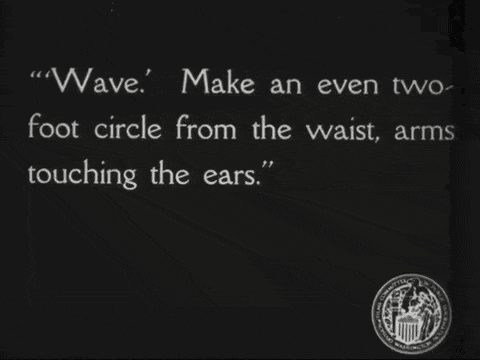
NARA gif from NARA ID 24715.
RETRO WORKOUT TIPS!
"Lets Get Physical" circa 1911-1952!
Check out these great exercise gifs from our new exhibit All American: The Power of Sports. Read Victoria Macchi's National Archives News story to learn more about these athletes: National Archives Debuts Sports GIF Pack to Fuel Your Retro Workout.
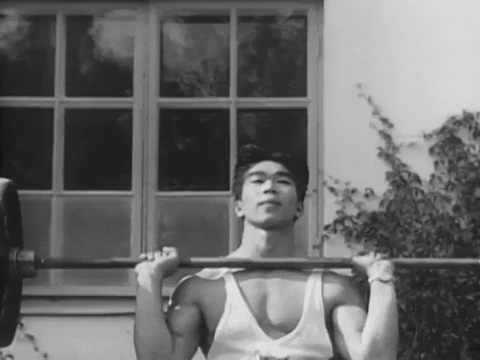
Tommy Kono, who learned to lift while imprisoned in an WWII incarceration camp then went on to become an Olympian. NARA gif from NARA ID 2569520.
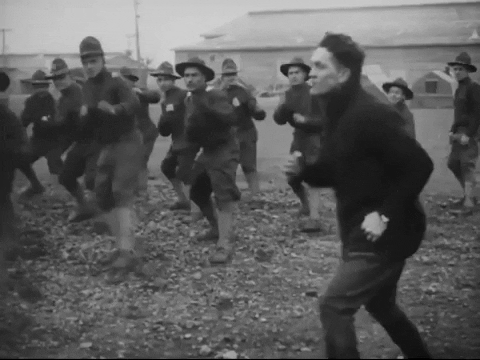
NARA gif from NARA ID 24715.

All American: The Power of Sports!
National Archives Museum, DC, 9/16/22-1/7/2024
This 3,000-square-foot exhibit showcases more than 75 items including original records, artifacts, and photographs. Highlights include original sports equipment and jerseys gifted by star athletes to Presidents, early 20th-century tobacco baseball cards, trophies, rare pictures and film footage, patents, and more! Press release here, National Archives News story here. All American: The Power of Sports is made possible in part by the National Archives Foundation through the generous support of AT&T, AARP, and Mars, Incorporated. Additional support provided by HISTORY® and the Lawrence F. O'Brien Family.
#sports#sports history#allamericansports#exercise#workout#bodybuilding#fitness#working out#gym#archivesallamerican
109 notes
·
View notes
Text
Indigenous knowledge; Chihuahuan and Sonoran desert landscapes; mining and nuclear colonialism in New Mexico; Quechua/Andean languages; epistemicide and imperialist erasure of Indigenous worlds/cosmologies through racialization of language: “translation” as extractivism. New autumn 2022 releases from University of Arizona Press.

Bountiful Deserts: Sustaining Indigenous Worlds in Northern New Spain foregrounds the knowledge of Indigenous peoples in the arid lands of northwestern Mexico, for whom the desert was anything but barren or empty. Instead, they nurtured and harvested the desert as a bountiful and sacred space. [...] [A]uthor Cynthia Radding develops the relationships between people and plants and the ways that Indigenous people sustained their worlds before European contact through the changes set in motion by Spanish encounters, highlighting the long process of colonial conflicts and adaptations over more than two centuries. This work reveals the spiritual power of deserts by weaving together the cultural practices of historical peoples and contemporary living communities, centered especially on the Yaqui/Yoeme and Mayo/Yoreme.

Contrary to previous works that suppress Nuevomexicana/o presences throughout U.S. nuclear history, Nuclear Nuevo Mexico: Colonialism and the Effects of the Nuclear Industrial Complex on Nuevomexicanos focuses on recovering the voices and stories that have been lost or ignored in the telling of this history. By recuperating these narratives, Myrriah Gómez tells a new story of New Mexico, one in which the nuclear history is not separate from the collective colonial history of Nuevo México but instead demonstrates how earlier eras of settler colonialism laid the foundation for nuclear colonialism in New Mexico.

Reading the Illegible: Indigenous Writing and the Limits of Colonial Hegemony in the Andes examines the history of alphabetic writing in early colonial Peru, deconstructing the conventional notion of literacy as a weapon of the colonizer. This book develops the concept of legibility, which allows for an in-depth analysis of coexisting Andean and non-Native media. The book discusses the stories surrounding the creation of the Huarochirí Manuscript (c. 1598–1608), the only surviving book-length text written by Indigenous people in Quechua in the early colonial period. The manuscript has been deemed “untranslatable in all the usual senses,” but scholar Laura Leon Llerena argues that it offers an important window into the meaning of legibility.

Visualizing Genocide: Indigenous Interventions in Art, Archives, and Museums, edited by Yve Chavez and Nancy Marie Mithlo, examines how creative arts and memory institutions selectively commemorate or often outright ignore stark histories of colonialism. The essays confront outdated narratives and institutional methods by investigating contemporary artistic and scholarly interventions documenting settler colonialisms including land theft, incarceration, intergenerational trauma, and genocide. Interdisciplinary approaches, including oral histories, exhibition practices, artistic critiques, archival investigations, and public arts, are among the many decolonizing methods incorporated in contemporary curatorial practices.

In Translation and Epistemicide: Racialization of Languages in the Americas author Joshua Martin Price tracks how through the centuries translation practices have enabled colonialism and resulted in epistemicide, or the destruction of Indigenous and subaltern knowledge. The book gives an account of translation-as-epistemicide in the Americas, drawing on a range of examples from the early colonial period to the War on Terror. The first chapters demonstrate four distinct operations of epistemicide: the commensuration of worlds, the epistemic marginalization of subaltern translators and the knowledge they produce, the criminalization of translators and interpreters, and translation as piracy or extractivism. The second part of the book outlines decolonial translation strategies, including an epistemic posture the author calls “bewilderment.”
-------
All text by: The University of Arizona Press. “Explore New Titles from the University of Arizona Press Fall 2022 Catalog.” Press release published online. 26 May 2022. [Italicized first paragraph/heading added by me.]
#really want the Translation as Epistemicide one#guessing epistemic bewilderment similar to concepts of refusal and opacity in Caribbean and latam lit#ecology#abolition#colonial#imperial#landscape
157 notes
·
View notes
Text
youtube
Cooking sushi in prison ! | From Incarcerated to Incorporated
Embark on a journey of transformation from “Incarcerated to Incorporated” with our groundbreaking culinary program, where inmates learn the art of cooking sushi in prison. This innovative initiative offers a unique opportunity for skill development and personal growth, empowering individuals to discover their potential within the confines of incarceration. Through mentorship, hands-on training, and teamwork, participants gain valuable culinary expertise, instilling a sense of purpose and hope for a brighter future. The keyword highlight, “cooking sushi in prison,” reflects the program’s creativity and determination to provide inmates with meaningful opportunities that pave the way for a successful transition to entrepreneurship and beyond. Join us in creating a pathway to new possibilities and a fresh start.
#cooking sushi#sushi cake#sushi making#sushi recipe#sushi rolls#cooking sushi in prison#from incarcerated to incorporated#culinary journey#redemption#resilience#mouthwatering flavors#sushi-making behind bars#unlikely setting#transformation#success story#personal journey#determination#entrepreneurship#challenges in prison#limited resources#artistry#second chances#inspirational#Youtube
1 note
·
View note
Text

Super excited for Unbuild Walls: Why Immigrant Justice Needs Abolition by Silky Shah (2024).
In the wake of post-9/11 xenophobia, Obama’s record-level deportations, Trump’s immigration policies, and the 2020 uprisings for racial justice, the US remains entrenched in a circular discourse regarding migrant justice. As organizer Silky Shah argues in Unbuild Walls, we must move beyond building nicer cages or advocating for comprehensive immigration reform. Our only hope for creating a liberated society for all, she insists, is abolition.
Unbuild Walls dives into US immigration policy and its relationship to mass incarceration, from the last forty years up to the present, showing how the prison-industrial complex and immigration enforcement are intertwined systems of repression. Incorporating historical and legal analyses, Shah’s personal experience as an organizer, as well as stories of people, campaigns, organizations, and localities that have resisted detention and deportation, Shah assesses the movement’s strategies, challenges, successes, and shortcomings. Featuring a foreword by Amna A. Akbar, Unbuild Walls is an expansive and radical intervention, bridging the gaps between movements for immigrant rights, racial justice, and prison abolition.
Also a 2022 reading list from Verso Books on the changing role of borders and how we consider freedom of movement, globalization, and humanitarian crises across the world.
2 notes
·
View notes
Photo


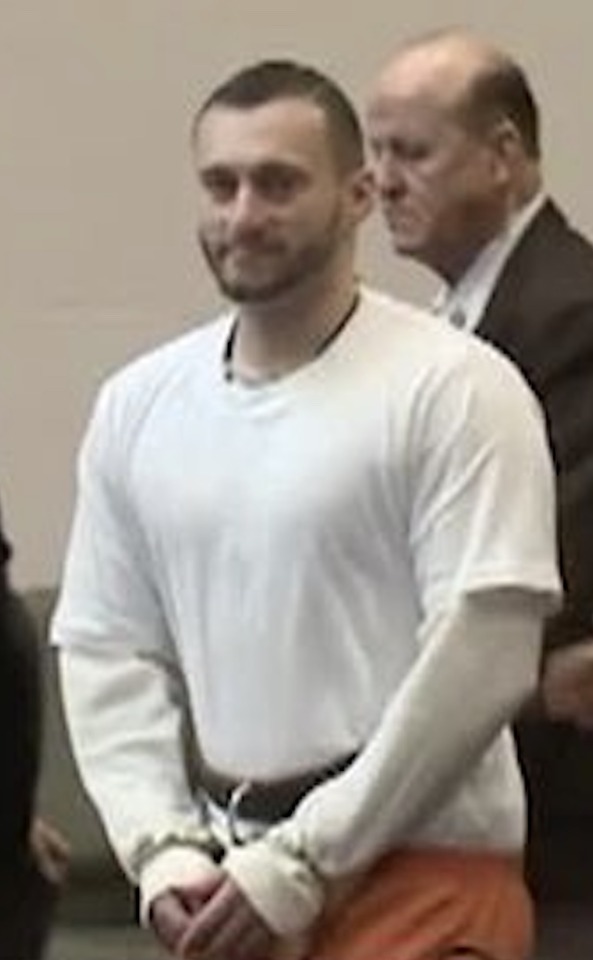


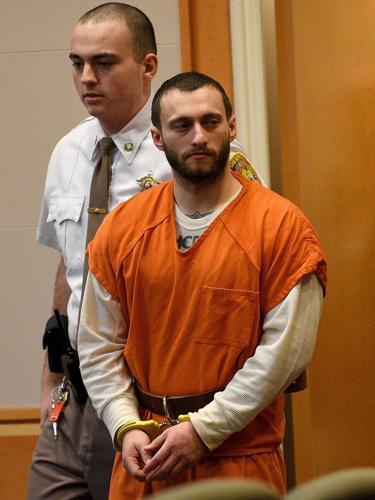

Post 798
Paul Arthur Joseph Dimick, New Hampshire inmate 87452, born 1991, incarceration intake in 2018 at age 27, (this time around) scheduled for full discharge on 08/18/2117 (Sentenced 30 years to life, for computation purposes ‘life’ means 100 years.)
Murder
Paul Dimick, the Manchester murderer responsible for an hours-long Central High School lockdown in 2018, said Monday that his victim was like a brother to him and “I’ll love you every minute that I rot away.”
That will be 30 years’ worth, according to the prison sentence that Dimick, 28, received.
Judge Diane Nicolosi sentenced Dimick in Hillsborough County Superior Court, a formality since he pleaded guilty to the second-degree murder of Justin “Drizzy” Lee. The sentence of 30 years to life was part of the plea bargain.
Nicolosi issued the sentence after two of Lee’s relatives castigated Dimick in their victim-impact statements.
At one point, both Dimick and Lee lived with Lee’s grandmother, who would purchase them food because she didn’t want them to go hungry, said Lee’s sister, Kim Allan.
“You took advantage of my grandmother, then you turned around and killed her grandson,” Allan said. The grandmother died about seven weeks after Lee’s murder.
The relatives portrayed a man skilled at drawing, writing poetry and telling jokes poorly. He liked to ride dirt bikes. And he fathered a child.
But, like Dimick, he was addicted to drugs. Both were also members of the Gangster Disciples gang.
Lee’s stepmother, Jodi Dukette, said the family had always hoped that Lee would turn his life around and leave the world of drugs and crime.
“Paul Dimick has taken that chance away,” she said.
The shooting death took place late on the morning of Friday, Sept. 7, 2018, the third day Manchester students were back to school.
Police and school officials put Central High School into “secure campus” status, which prevented anyone from arriving or leaving the campus.
Some movement was allowed inside the school, but students were confined to their classrooms after the school day ended at 2:50 p.m. Police let students leave about 10 p.m.
Principal John Vaccarezza said students handled the situation very well, calming one another and forming a bond that lasted throughout the year.
“When you’re with people for that amount of time, in some ways you get close to people that you wouldn’t have,” he said. It was a learning experience for school officials, who have incorporated lessons from the incident into their safety drills.
“We got a real frame of reference about how things can play out,” Vaccarezza said.
Dimick shot Lee after his friend pilfered some electronics and clothes from the apartment hallway landing where Dimick was sleeping. According to previous testimony, he told his girlfriend he planned to kill Lee and would end up in prison for the rest of his life.
One witness told police he saw Dimick put a gun to Lee’s head and say “Yo. You want to rob me?” He then shot Lee underneath the armpit.
Dimick’s public defender said Dimick was exposed to crack cocaine in his mother’s womb and lead paint in his home. A doctor once recorded unexplained burn marks on his body.
He saw his parents fight and once witnessed his father getting pistol-whipped.
At times, his father would give him $100 just to leave the apartment for a day. The family could not afford the drugs needed to help Dimick at school, where he suffered taunts and humiliation, his lawyer said.
He started smoking marijuana at 10, and using hard drugs at 13. “Paul came to find out that using drugs was the only thing he was good at,” said public defender Sarah Amorin.
When a mental health counselor told Dimick recently that he was not developmentally disabled, Dimick refused to believe it, Amorin said.
Amorin said Dimick and Lee had a brotherly bond, and that was part of the reason for Dimick’s strong reaction to the theft.
“We just needed to get away from the streets,” Dimick wrote in a poem to Lee that he read during the sentencing hearing.
The sentence included a recommendation that Dimick be incarcerated out of state, preferably Maine or Vermont. Prosecutors would not discuss the reason for the request.
He waived the ability to seek a sentence reduction and to earn reductions for fulfilling education or other goals. He received a suspended sentence for disposing of the gun used to shoot Lee.
2d
28 notes
·
View notes
Text
Visual Culture & Political Art : Angela Davis as an Afrofuturistic Icon
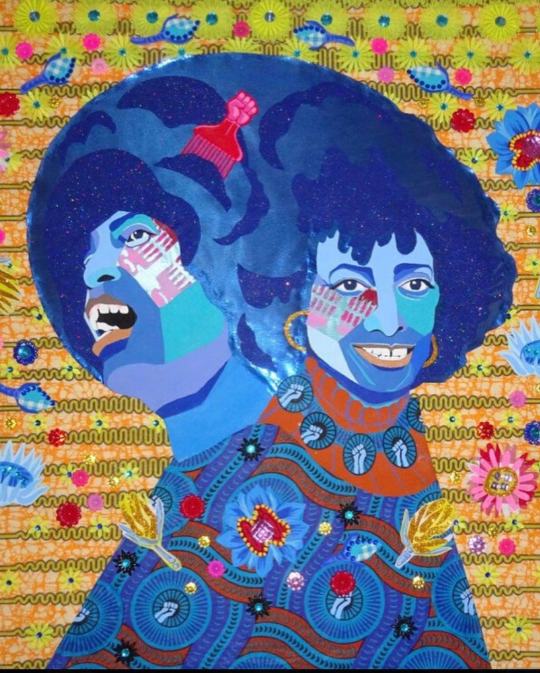
"Our Queen" by Erin LeAnn Mitchell
Angela Davis, an influential figure in civil rights and feminism, transcends conventional narratives as an Afrofuturistic icon, reshaping cultural perceptions through the dynamic interplay of visual culture and political art. Her iconic image, characterized by the defiant afro hairstyle and raised fist, becomes a symbol of resistance and empowerment within the framework of Afrofuturism. Angela Davis's visual representation, particularly in Erin LeAnn Mitchell's "Our Queen," extends beyond aesthetics, embodying the core vibe of Afrofuturism. It further delves into the intersection of visual culture and political art, highlighting Davis's role in challenging historical norms and envisioning a future where identity and culture are redefined on individual terms.

Afrofuturism, a cultural and artistic movement, combines elements of science fiction, speculative fiction, and fantasy to explore themes such as identity, culture, and liberation. It serves as a vehicle for political imagination, enabling marginalized communities to envision and create alternative realities. Erin LeAnn Mitchell's "Our Queen" exemplifies the evolution of Afrofuturist art, emphasizing empowerment and identity for black women and portraying Angela Davis at different stages as a metamorphosis over time. Afrofuturism celebrates the diversity of black experiences, challenging monolithic portrayals of blackness and embracing a multicultural perspective. Erin Mitchell's art challenges the portrayal of blackness by incorporating vibrant colors that represent spiritual elements and multi-layered comfort. Angela Davis, as a global and multicultural icon, signifies liberation for women of color across various cultures.
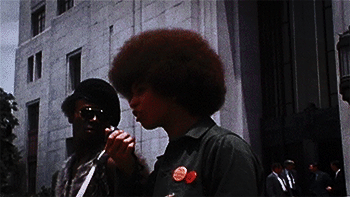
Beyond being an Afrofuturist icon, Angela Davis disrupts traditional beauty standards and advocates for the liberation of black women. Her image as a political prisoner turned professor, author, and public intellectual symbolizes liberation for all. The iconic raised fist signifies resistance and solidarity, turning her image into a form of political art that transcends mere representation. Davis's image defies binary oppositions, encouraging the blurring of boundaries and a more inclusive future. The representation of Angela Davis's body in Afrofuturist art challenges historical and societal norms. In "Seeing Differently" by Amelia Jones, the concept of "Bodies on Display" is explored, highlighting how visual culture can redefine societal perceptions of the body. Davis, through Afrofuturist art, represents a woman with agency over her own body, challenging the commodification of black bodies and influencing the visual culture discourse.

Angela Davis's Afrofuturistic representation reconceives difference by challenging stereotypical portrayals of women of color. Angela Davis's visual representation is inseparable from her involvement in various political movements. From her early activism in the Black Panther Party to her fight against systemic racism and mass incarceration, Davis's iconography displays the spirit of resistance and the pursuit of justice. Mitchell's artwork captures the duality of Davis's political journey, from the young, vital activist with the raised fist to the wise and peaceful intellectual, symbolizing the multifaceted nature of her contributions to political movements. In the context of visual culture, the notion of "Seeing Differently" is central to understanding how Afrofuturism provides an alternative perspective. Afrofuturism invites viewers to see beyond conventional norms, envisioning a future where difference is celebrated rather than marginalized.
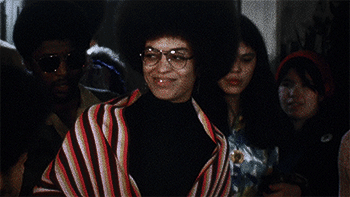
Angela Davis's iconography becomes a crucial component in the visual history of Afrofuturism, where identity is not confined by external expectations but defined by one's own terms. In "Seeing Differently," Amelia Jones theorizes the relationship between identity and visual history, emphasizing how visual representations contribute to the construction of identity. Davis's evolution from political prisoner to iconic Afrofuturist figure represents a dynamic shift in visual history, challenging preconceived notions and inspiring new narratives. The feminist slogan "The personal is political" resonates strongly in Angela Davis's image and artworks like "Our Queen." Davis's personal journey, from incarceration to academic prominence, is intrinsically tied to her political activism. The Afrofuturistic representation of Davis as a queen signifies not only personal triumph but also a collective political statement. Mitchell's artwork encapsulates the personal and political dimensions, illustrating how Davis's identity and visual representation contribute to broader societal change.
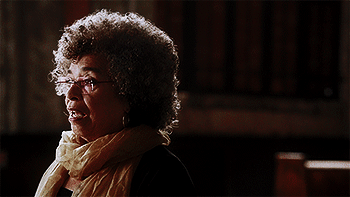
Davis's Afrofuturistic iconography stands at the intersection of visual culture and political art, challenging historical norms and influencing contemporary discourse. Visual culture, as an essential aspect of Afrofuturism, becomes a tool for political expression and reclamation. Davis's image, whether as a professor, activist, or global icon, embodies the transformative potential of visual culture in shaping societal perceptions and advocating for political change. Angela Davis emerges as a powerful Afrofuturistic icon, navigating the realms of visual culture and political art to challenge historical norms and envision a future where identity and culture are redefined on individual terms. Through her iconic image and Mitchell's Afrofuturist artwork, Davis becomes a symbol of resistance, empowerment, and inclusivity. Afrofuturism, with Davis at its forefront, invites a reevaluation of visual culture's role in political expression, paving the way for a more dynamic and inclusive cultural narrative. The concept of worldview, as discussed by Amelia Jones in "Seeing Differently," adds another layer to the Afrofuturistic exploration. Davis's visual representation, both in her iconic images and Mitchell's artwork, offers a distinct world view that challenges and expands societal perspectives. Afrofuturism, with Davis at its forefront, becomes a lens through which alternative worldviews are explored, emphasizing the importance of diverse narratives and challenging the dominant culture.

References:
Jones, Amelia. Seeing Differently. https://www.amazon.com/Seeing-Differently-History-Theory-Identification/dp/0415543835
"Afrofuturism and Its Possibility of Elsewhere: The Power of Political Imagination." The Conversation, https://theconversation.com/afrofuturism-and-its-possibility-of-elsewhere-the-power-of-political-imagination-166002.
"Wearing My Afro: Always a Political Act." The New Republic, https://newrepublic.com/article/122515/wearing-my-afro-always-political-act
"Afrofuturism: How Black Creatives Point to a Brighter Future." Domestika, https://www.domestika.org/en/blog/6930-afrofuturism-how-black-creatives-point-to-a-brighter-future
"Afrofuturism." UCLA Newsroom, https://newsroom.ucla.edu/magazine/afrofuturism.
"Artist Profile: Erin LeAnn Mitchell." Ruckus Journal, https://ruckusjournal.org/Artist-Profile-Erin-LeAnn-Mitchellh.
"Our Queen" by Erin LeAnn Mitchell, National Museum of African American History and Culture, https://nmaahc.si.edu/object/nmaahc_2010.55.2.

2 notes
·
View notes
Text
Despite Murillo having a lengthy history of violence against women – including the assault of another woman with a metal bar on a separate occasion — he was transferred to a women’s jail within the provincial system during his trial. Notably, Murillo had asked for his alleged ‘gender identity’ to only be used for the purposes of his jail placement and to remain obscured from the court.
A trans-identified male currently serving life in prison for the 1995 murder and post-mortem sexual assault of a woman has been transferred to a female correctional facility in Ontario, Canada.
On April 22, the Parole Board of Canada issued a decision in the case of Catherine Lynn — a trans-identified male incarcerated for the 1995 murder of a woman in her apartment. Lynn physically assaulted the victim before slashing her throat and raping her corpse. Lynn, whose birth name is still being verified, had applied for parole and was rejected on the grounds that he continued to be an “undue risk” to society.
At the time, the decision noted that Lynn had applied for transfer out of his current facility, but had redacted the type of facility he was seeking to be moved into, ostensibly in an attempt to obscure the fact Lynn was transgender and had been housed in a male prison.
But, according to Heather Mason, a former inmate-turned-women’s rights advocate, a female inmate at the grand Valley Institution for Women has confirmed Lynn is now in the facility, just months after the Parole Board noted his desire to be transferred.
On September 13, Mason announced on her Twitter that she had received documents from the Parole Board confirming what her source in the Institution had reported. Mason, whose focus is on supporting incarcerated women in Canada, provided those documents to Reduxx for review.

In their decision, the Parole Board of Canada noted that Lynn, now 68, had initially lied to police about the crime he committed after being arrested in September of 1995.
“At first, you said you found the victim deceased in her apartment, however, you later admitted to police that you killed the victim.” Lynn would eventually admit to having committed the horrific slaying, and would go on to plead guilty to second degree murder.
In denying his parole, the Board also mentions Lynn’s previous incidents of violence, which included a 1974 conviction for Assault Causing Bodily Harm and a withdrawn 1993 charge for assault against a prostituted woman. The decision makes specific note of Lynn’s size and strength, as well as his history of violence against women. When Lynn began identifying as transgender is currently unknown.
Prior to the 1995 murder, Lynn had spent “a number of years” in psychiatric facilities.
While some parts of the document are redacted, Mason managed to provide clarity using discussions she has had with inmates at Grand Valley. The incarcerated women reportedly told Mason that Lynn had been seeking to study how the women “walked, talked, and acted” as part of his transition plan. He has also been approved for ‘gender affirmation’ surgery.

The decision also notes that Lynn has had an extensive history of problematic behavior while incarcerated, noting that his record is “marred by a number of incidents related to inappropriate sexual behavior with others, poor conflict resolution, and inappropriate dress.”
Male inmates who identify as ‘women’ in Canada have been able to request transfer to female facilities since 2017, when Bill C-16 was passed. The Bill incorporated gender identity and expression as protected characteristics for which a person could not be discriminated against.
While the Correctional Services of Canada has previously attempted to keep extremely high-risk male offenders out of women’s institutions under the pretense of being inadequate to prevent escape, a precedent set in 2019 in the Boulachanis v. Canada case effectively rendered that caveat ineffective.
Jamie (born John) Boulachanis was charged with the murder of Robert Tanguay in 2016. Boulachanis, who was involved in organized crime, killed Tanguay after becoming paranoid that he was a police informant, and hid his body in a sand pit for almost 2 decades. During his trial, Boulachanis managed to escape immediate custody multiple times, and was thus considered a flight risk too difficult to manage for the often-lower security women’s institutions. Boulachanis sued the Canadian government for the transfer after coming out as transgender in 2018, and was eventually granted it by a court under the basis of gender discrimination in 2020.
While that ruling was initially overturned by the Federal Court of Appeal, Boulachanis eventually underwent taxpayer-funded ‘gender affirming’ surgery and was formally transferred to a women’s facility in 2021.
Since then, there have been multiple cases of violent male offenders seeking transfer or being housed in women’s jails and prisons.
Last year, Yostin Murillo, 25, was sentenced to life in prison for the violent murder and rape of Toronto nurse, Rhoderie Estrada.
In 2018, Murillo, along with accomplice David Beak, broke into Estrada’s home in East York, Ontario with the intention of robbing the residence. Estrada was sexually assaulted while her three young daughters slept just meters away down the hall.
As she continued to resist, the two predators bludgeoned her in the head multiple times with a metal bar – striking her at least eight times, and leaving her face “unrecognizable” to her husband when he came home later that night from work.

Estrada’s husband reportedly had attempted to clear his dying wife’s mouth of blood and perform CPR in a last-ditch effort to keep her alive until emergency first-responders arrived, but, according to court testimony, “her teeth kept falling out.”
Murillo was arrested after being found in possession of Estrada’s iPhone, which was still stained with her blood.
Despite Murillo having a lengthy history of violence against women – including the assault of another woman with a metal bar on a separate occasion — he was transferred to a women’s jail within the provincial system during his trial. Notably, Murillo had asked for his alleged ‘gender identity’ to only be used for the purposes of his jail placement and to remain obscured from the court.
Murillo’s current placement is unverified, but there had been discussion and debate following his trial surrounding the possibility he would seek transfer to a women’s correctional facility.
At the end of August, Reduxx reported that a violent male sex offender had begun identifying as transgender and had requested leniency in his sentence as a result.
Jody Burke, who has been convicted of sexual assault on three separate occasions, has stated his violent past actions were prompted by a “sexuality crisis” and “gender dysphoria.”
Speaking to Reduxx on Burke’s case, Heather Mason predicted he would request transfer to a women’s correctional facility.
“I believe he will try to gain access to the women’s prison,” Mason speculated. “If he is denied, he will start a Human Rights claim that opens the door to him receiving money because [Correctional Services of Canada] has discriminated against his gender identity.”
By Jennifer Seiland Jennifer is a founding member of the Reduxx team, writing with a focus on crimes against women and sex-based rights rights advocacy. She is located in the American south where she is a passionate animal welfare advocate and avid coffee drinker.
25 notes
·
View notes
Text
ENCYCLOPEDIA OF
COLLECTIONS:
VOSS
Spring/Summer 2001; Gatliff Road Warehouse, London; 26 September 2000
McQueen had always declared that he wanted his shows to elicit a strong audience reaction. Voss, one of his most celebrated, achieved that result. An enormous clinical glass box formed the centrepiece, constructed to resemble a padded cell in a psychiatric hospital with white tiled floors and walls formed from surveillance mirrors. From the outset the mood was tense; the audience forced to endure an hour-long wait, staring at their own reflections whilst listening to the unnerving pulse of a heartbeat. Eventually, the light levels in the glass box rose to reveal models trapped in the cube, who were unable to see the audience.
Depictions of madness and incarceration were the principal inspirations behind the collection’s presentation. While the psychiatric hospital was most readily identifiable, Frank Darabont’s film The Green Mile (1999), which told the stories of inmates on death row, provided an alternative notion of confinement.
Voss, like so many of McQueen’s collections, harnessed multiple, disparate themes which coalesced into the designer’s unique vision of beauty. The title – the name of a Norwegian town renowned as a wildlife habitat – suggested the collection would celebrate nature. Bodices, skirts and dresses constructed from razor-clam, mussel and oyster shells astonished the audience with their elegance and ingenuity. McQueen’s love of birds found expression in feather skirts, and in a headdress composed of taxidermied hawks, which hovered perilously above a model and appeared to claw her hair through the bandages that swathed her head. The notion of medical scrutiny was starkly conveyed in a vermillion ensemble, modelled by Erin O’Connor, which comprised a skirt of dyed ostrich feathers and bodice of microscope slides hand-painted red to hint at the blood beneath the skin. The sharp glass of the slides hanging delicately from the bodice also mimicked the soft feathers
on a bird’s chest.
McQueen’s fascination with the Orient was explicit in designs featuring appliquéd chrysanthemum roundels; an embroidered grey silk ensemble with real amaranthus dangling from the rectangular headpiece; and a dress that incorporated the panels of an antique Japanese silk screen atop a skirt constructed from 80 polished black oyster shells. The look was completed by a neckpiece of silver branches, adorned with clusters of Tahitian pearls. The finale was the most transgressive of any of McQueen’s catwalk shows: a recreation of Joel-Peter Witkin’s Sanitarium (1983). As the models dispersed and the soundtrack of a pulsing heartbeat gave way to a flat-line monotone, the glass box shattered to reveal the voluptuous, naked figure of fetish writer Michelle Olley, reclining on a horned chaise longue in the graceful pose of a Botticelli painting, her masked head bowed and attached to a breathing tube. Moths fluttered about her before the lights dimmed and left the audience to ponder the meaning of beauty.
— Kate Bethune, Senior Research Assistant, Alexander McQueen: Savage Beauty. ‘Encyclopedia of Collections’ in Alexander McQueen, ed. Claire Wilcox, V&A Publishing 2015
16 notes
·
View notes
Note
any tips for going about researching specific legal stuff without a legal background? like a while ago i was wondering if an incarcerated person would able to legally adopt an adult or child while still in prison, but all i kept getting in my results revolved around giving up your guardianship when incarcerated, even as i changed the search terminology and phrases in quotes and what not. now, I’d like to incorporate some lawyer!matt in a long fic i plan on writing but i’m tentative about diving in. like, a big problem is that i don’t even know how to find the right legal terms to start searching with, and that combined with interference from common searches and ads derails things quickly. I know that it won’t be completely accurate no matter what, but i’d like to land in the ball park (or at least the parking lot of the ball park) so…any pointers on how or where to poke around? (thanks)
This is such a good question because you're so right: if you don't know the vocabulary, all the search skills in the world will be of minimal help. But obviously if you don't know the vocabulary, you don't know the vocabulary. Frankly, legal research is like trying to do research in another language.
Generally, I would recommend starting broad, and then narrowing your focus. So for the adoption/incarceration idea, I would start by researching adoption law generally and prisoner's incarceration privileges generally, and just learning about the jail system generally. These broad searches are likely to reveal the specific vocabulary for a narrower search.
However, that admittedly takes a lot of time.
Another approach is to use this website, which I love, and has a specific section for definitions, as well as good break-downs of different parts of the justice system. I also have this post which includes some definitions and explanations of parts of the justice system, though it's probably not as well-written as the website. XD
The downside with this approach is that you still might not get that specific information you really need.
Another thing you can do is DM me, or send me asks specifically about your current question! I love lawyer!Matt fics and am happy to do all I can to increase the number of them in this fandom!
Good luck! <3
5 notes
·
View notes